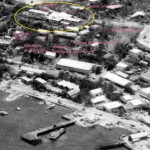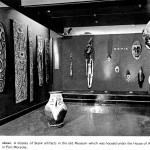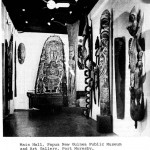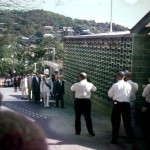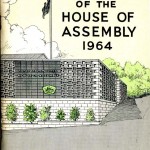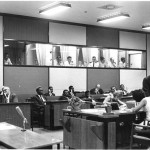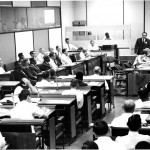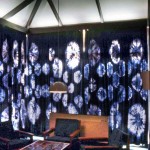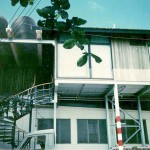Just because this surprise visit was just that, a surprise showing of a whole integrated new range of cultural production, from an unexpected area (previously unpublicised, forgotten?) this has been an opportunity to introduce the PNG cultural material in a relatively inclusive way.
We can see this in material from other areas later, but for now here is some of the other material culture from Samgik that adds a bit more scope to the art featured in the previous post.
The first image shows bilums made by the women hanging off the various figures and totems of the carved lintel, ‘ticket’, of the haus tambaran at Samgik in August 2013. Obviously here, and as they are in the neighbouring Abelam cultures bilums like these are integral to the traditions, and origin legends of the Wama and their affiliated cultures.
Art on Yams
July-August is the time for yam festivals in the Abelam and other areas around Maprik. The main harvest is over and some of the prize yams are starting to shoot, so those are ready to contribute their offshoots to the new season. Prize yams are cultivated by their skilled initiated male growers to be big (almost person height) and to attain anthropomorphic shapes and are decorated appropriately for display at the festival, which has the added edge of a fertility rite atmosphere to start the new season’s plantings.
The prize yams here are shown standing in front of the haus tambaran, the usual backdrop for the festival ceremonies. At Brikiti the next day another display of yams had them laid horizontal with their headrests upright behind them. A week earlier there had been a yam festival at Milak, a village to the north of Brikiti and I had seen guys there decorating some that lay horizontal the day before the festivities. Villages that maintain some affiliation arrangements with each other around the Maprik district attend each others’ festivals, and exchanges take place as well.
Bilums
The bilums displayed on the Guest House at Samgik were made by women of the Wama cultural group and were very fine examples of these usually exquisitely designed, and well crafted works of art. The ones on the facades here are made in the plant fibre and natural dye traditional, for which the Maprik area was once very famous.
Bilums can be seen as purely utilitarian objects, but to look at them that way is to miss the point that here is displayed high aesthetic sensibility. These objects certainly are rugged and can carry objects well, but they also carry strong symbolic and ritual meanings, even to the point where they often codify the identity and ples of their makers.
Obviously for the Wama at Samgik, and certainly for the Abelam (and for the Kwoma in slightly different ways) the bilum is highly symbolic and is integral to key origin stories. Bilums feature on Abelam haus tambaran facade artwork as, what can appear to outsiders, as abstract infil decoration. But they are not included on these current Samgik facade panels. Nevertheless, bilums are displayed on the skirts to the facades here in much the same way as they are on Abelam haus tambaran fronts for events like openings and special occasions.
If you want a really good reference book with thorough explanations and including great images and even beautiful drawings of the techniques of looping involved see : Maureen MacKenzie. Androgynous Objects: string bags and gender in central New Guinea, Harwood Academic, 1991.
Pottery
The women of the Abelam, the neighbouring Wosera and other surrounding groups made pottery some of which was decorated by men who incised and painted colourful traditional images with figures and totems. The ones shown are plain forms with only surface decoration. Reputed to have died for many years, pottery seems to be making a come back from the Kwoma to some areas around Maprik. It is refreshing to see that women are keen now to have their art skills revived, and made available to the market again.
Kundu drums
This is a hand held drum made out of light wood with a snake or lizard skin membrane stretched taut to form the sounding surface which is fixed to one end. That is treated with a beeswax type resin which helps in producing a distinct resonating timbre by making parts of the acoustic skin sticky to the touch. The kundu shown here is a special, patterned, relatively solid and elaborately decorated example.
Dance and Body Art
For the performances we saw at Samgik there was mostly decorative apparel and apparatus rather than face painting applied to the dancers. Here we see skirts, arm, and ankle bands, kinds and bilums. The detail image show decorated dancing sticks carried and danced with by the women.
Art on Architecture
Samgik follows a pattern somewhere formally between their northern and eastern Abelam neighbours and their western Ilahita ones. I will look at the architecture itself later and make comparisons across groups, and hopefully across time. This is just a visual introduction to these graphic related large objects that are a cultural focus in may ways. They act as a stage and backdrop as we see in the way the dances were performed here on our visit. Normally the sort of art seen in the Wama Guest House, or its more tradition and sometimes secret versions are housed within, and in turn host initiation ceremonies. And before the initiation of festival the interior functions as a workshop-studio for the production of the artworks (the facade panels and its lintel, the sculptures and interior painted panels, maybe material for yam festivities, and so on.)
Hopefully this entry helps give an indication of the comprehensive nature of the art production proudly put on show by the associated culture groups represented at Samgik in mid 2013.
Wama Guest House
The guest house is a hybrid form with a more secular, a modern function, rather than that seen in the traditional haus tambaran. The form again is an interpretative representation of a bird form with the wings extended maybe like a hen sheltering its chicks. The head is the peak with the conical cap. Similar shaped forms housing stage/rostrum functions were seen at Ilahita in the important sacred places which are still communal gathering spaces where public meetings are held and announcements made. At Samgik this building came before the haus tambaran. It seems to me to have elements that may have been a bit of trail run before embarking on the much higher stake venture that the haus tambaran represents.
Samgik Haus Tambaran
We will look at the haus tambaran in more detail, and across cultures and time in a future entries. But here is a glimpse of the house as an object, and its painted art in detail. Part of the painted panel is here and the lintel detail is above.





































